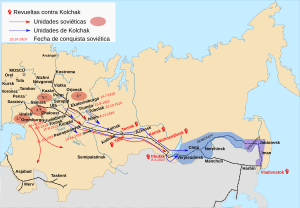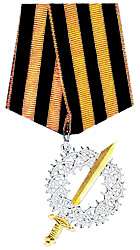Great Siberian Ice March
The Great Siberian Ice March (Russian: Великий Сибирский Ледяной поход, Velikiy Sibirskiy Ledyanoy pokhod) was the name given to the 2000-kilometer winter retreat of Admiral Kolchak's Siberian Army from Omsk to Chita, in the course of the Russian Civil War between 14 November 1919 and March 1920.
| Great Siberian Ice March | |||||||
|---|---|---|---|---|---|---|---|
| Part of the Eastern Front of the Russian Civil War | |||||||
 Retreat of the White Army (Nov. 1919 - March 1920). | |||||||
| |||||||
| Belligerents | |||||||
|
|
| ||||||
| Commanders and leaders | |||||||
|
|
| ||||||
General Vladimir Kappel, who was appointed to this position in mid-December 1919, led the retreat. After his death from pneumonia on 26 January 1920, General Sergei Wojciechowski took command of the troops. Admiral Kolchak travelled ahead by train to Irkutsk but was halted by Czechoslovak troops in December and handed over to Left SR troops in Irkutsk on 14 January, which executed him on 7 February 1920.
Prelude
In the summer of 1919, the Red Army had gained a great victory against Kolchak's Army. The White forces re-established a line along the Tobol and the Ishim rivers to temporarily halt the Red Army, which was faced by an advance on Moscow from the south by Anton Denikin's White Army. By the autumn, Denikin had been defeated and the Red Army was able to direct reinforcements back to the Eastern Front. The Reds broke through on the Tobol River in mid-October and by November the White forces were falling back towards Omsk in a disorganised mass. Omsk was conquered by the Reds on 14 November 1919.
The retreat from Omsk to Lake Baikal
The retreat began after the heavy defeats of the White Army in the Omsk operation and in the Novonikolaevsk Operation in November–December 1919. The army, led by General Kappel, retreated along the Trans-Siberian Railway, using the available trains to transport the wounded. They were followed on their heels by the 5th Red Army under the command of Genrich Eiche.
The White retreat was complicated by numerous insurgencies in the cities where they had to pass and attacks by partisan detachments, and was further aggravated by the fierce Siberian frost. After the series of defeats, the White troops were in a demoralized state, centralized supply was paralyzed, replenishment not received, and the discipline dropped dramatically.
In these circumstances, the appointment as commander of the Army of General Kappel, who enjoyed unlimited trust and prestige amongst Kolchak's troops, was the first step to avoid the disintegration of the entire Kolchak army. Only the 2nd Army came under his command, as communication with the 1st and 3rd armies had been lost. Control of the railway was in the hands of the Czechoslovak Legion, as a result of which parts of General Kappel's Army were deprived of the opportunity to use the railway. They were also harassed by partisan troops under command of Alexander Kravchenko and Peter Efimovich Schetinkin.
The pursuing Red 5th Army took Tomsk on 20 December 1919 and Krasnoyarsk on 7 January 1920.
The march across Lake Baikal
Vladimir Kappel's 2nd Army came to a halt on the shore of Lake Baikal near Irkutsk in January 1920. With the Red Army in hot pursuit, the White 2nd Army (the Kappelevtsy), had to escape eastwards to Chita across the frozen Lake Baikal in sub-zero temperatures. About 30,000 White Army soldiers, their families and all their possessions as well as the Tsar's gold, made their way across the lake to Transbaikalia.
The bloodiest campaign battles occurred at the villages of Yakovlevka, Birulka, and Gruznovskaya, as well as the city of Barguzin.[1]
As the Arctic winds blew unobstructed across the lake, many in the army and their families froze to death. Their bodies remained frozen on the lake in a kind of tableau throughout the winter of 1919–20. With the advent of spring, the frozen corpses and all their possessions disappeared in 5,000 feet of water. Kappel himself was struck by frostbite and pneumonia while leading his survivors along a frozen river in temperatures of -40 °C (-40 °F); he died on 26 January.[2]
End of the March
The survivors of the March found a safe haven in Chita, the capital of Eastern Okraina, a territory under control of Kolchak's successor Grigory Mikhaylovich Semyonov, who was supported by a significant Japanese military presence.
The Central Committee of the Russian Communist Party issued an order not to advance any further beyond Irkutsk, to avoid a military conflict with Japan, at a moment when the main threat for the young Soviet State was in Europe (Poland).
Sources
- This is a translation of an article in the Russian Wikipedia, Великий Сибирский Ледяной поход.
Notes
- Ледяной поход 3-го Барнаульского стрелкового полка (Северный путь) (in Russian). Тернистый путь. Однодневная газета. 1 февраля 1921 г. Издание Владивостокского объединенного комитета по устройству недели каппелевцев. Retrieved 2009-11-08.
- Evan Mawdsley (2007). The Russian Civil War. Pegasus Books, 2007, p. 211. p. 231. ISBN 9781933648156. Retrieved 18 April 2010.
